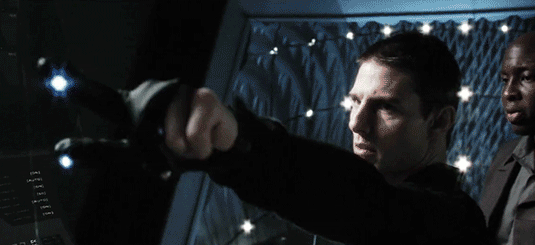I remember vividly the scene from Minority Report, where Chief Anderton (Tom Cruise) is looking at a transparent monitor, reviewing images and manipulating them with hand gestures. I recall not being incredulous, but rather accepting that the gesture-based interface was not far-fetched. Fact check: Minority Report was written in 1956 as a science fiction novella, and the movie was released in 2002; the first iPod Touch was released in 2007 and the first iPad was released in 2011. In fact, 8 years after the Minority Report movie release, a 2010 article in MIT News reports a gesture-based interface being developed by two graduate students. Here we are in 2021, potentially closer to that reality, right? Maybe? I’m not sure.

Minority Report. Directed by Stephen Spielberg. Performance by Tom Cruise. 20th Century Fox, DreamWorks Pictures, Amblin Entertainment, and Blue Tulip Productions, 2002.
Despite that, I wonder not if we will get to gesture-based interaction with the digital world, but when. While we may not be completely there yet today, I believe that the speed at which we create digital twins today may bring us closer to those interactions, perhaps sans gestures, but certainly with an immersive experience.
I posit that enterprises with distributed facilities, regardless of how many or few, are begging to digitalize, even without gesture-based interfaces. Why? Because our workflows are spread across too many platforms, most of which are not integrated. Even when the information is available in a unified dashboard or platform, the lack of context challenges us to fully comprehend the information. Allow me to expand.
Take for example the performance, health or availability of a machine. You may have IoT sensors in your manufacturing line measuring pressure, vibration, temperature or any number of metrics important to the proper functioning of a machine. But when you have multiple machines displaying their statuses in a dashboard, how can you tell exactly which machine it is on your line? Is machine 3 the third one from the right or the third one we installed? And if your sensors indicate maintenance or repair is required, how do you best prepare for the job if you don’t have context of the machine's surroundings?
Likewise, enterprises are using training videos to great effect as teaching tools for operational, procedural and safety training. It’s great to watch them in a remote classroom, and they are quite effective. But again, wouldn’t the videos be more effective if they were watched in the context of where the actual work would take place?
I believe the missing link between the information we are presented and the context of the information is the digital twin.
Walk with me.
Imagine I work for a discrete manufacturing company and I’m a machine operator. Let’s say my company has implemented a digital twin and granted me access via my mobile device. As I step onto the manufacturing line, I receive a pop-up notification on my device showing me the most current safety checks I need to carry-out prior to operating the machine. In fact, if I don’t remember how to complete the safety check, the most current video within the pop-up is available, showing me exactly what I need to do. Also available to me is the machine’s operations manual, the health and performance metrics in pop-up charts, the maintenance history, etc. And if I needed to schedule the machine manufacturer’s technician to carry-out routine maintenance on the machine, or order a part for it, I could do it right there at the machine, with all information pre-filled. And what if I needed to consult with the manufacturer? I could invite them to view my digital twin with me, with them helping me from afar.
Far-fetched? I don’t think so. In conversations with our customers and partners, I know for sure the above scenario is desired and a prized destination, one many are pursuing. In fact, some are well on their way to implementing digital twins that do exactly that.
Even without gesture-based interfaces, I think digital twins provide an opportunity to create immersive experiences. I think the right digital twin solution, especially augmented with layers of information and integrated with an enterprise's operational and business workflows, will certainly bring us closer to that true sense of presence. Not entirely, but close enough for the digital twin to be the new soul of the digital enterprise. What do you think?